
HOME � REVIEWS � CONTACT � LINKS � ARCHIVES � FORUMS
 |
| HOME � REVIEWS � CONTACT � LINKS � ARCHIVES � FORUMS |

|
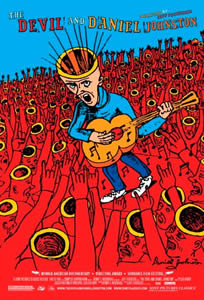 Daniel Johnston and brothers Jad and David Fair�the subjects of director Jeff Feuerzeig�s documentaries �The Devil and Daniel Johnston� and �Half Japanese: The Band That Would Be King��are both topically and psychically linked. Daniel and Jad make a likely pairing; they complement one another well, each�s music offbeat and inept in its own way, but eerily similar, as if they were borne of the same essence. And yet, they are so inherently different from one another that it profoundly affects the tone of each film. �The Devil and Daniel Johnston,� the story of the singer/songwriter/artist�s descent into mental illness, is unique in that it�s shot on 16mm film, is well-lit, involves dolly shots and motion control; it required a much larger budget than the average documentary but the outcome is a beautifully shot, visually appealing film in the tradition of documentarians like the Maysles and Errol Morris. While the accessibility and relative cheapness of digital equipment is liberating for many aspiring filmmakers, aesthetic quality is often sacrificed considerably in the process�just because virtually anyone with a computer and a little bit of money can make a movie does not mean that everyone should. Feuerzeig�s work is a refreshing departure from this recent trend of mediocrity. One of the most significant aspects of �Devil� is the source material. Daniel Johnston, a self-archivist to an obsessive degree, has over the years recorded thousands of Super 8 films and audio diaries, which this movie makes clever use of. The Super 8 films range from simple self-documentation to more creative projects, which often employ stop motion effects. The most memorable of these is �It Must Be Monday,� in which Daniel plays both himself and his mother, adorning a curly wig and bathrobe and wielding a rolling pin, berating Daniel and attempting to feed him what appears to be popcorn drenched in dark green Kool-Aid. (Sadly, many of these films have been severely damaged by mold over the years, hence the �snowflake� effect that often appears on the screen.) At some point the filming seems to focus more on documenting Daniel�s life, accompanied with audio recordings of not only his thoughts and feelings, but his conversations. These tape recordings are also innovatively utilized, visually accompanied by either a close-up of the actual tape playing (when the track is on the shorter side), or striking, brightly colored recreated scenes: for example, Laurie Allen�s husband�s funeral home, Daniel�s recording studio in his brother�s garage in Houston, the carnival that brought him to Austin, and various others. The amount of detail in these scenes is impressive, from Daniel�s Casper glass positioned on the chord organ, to the corn dogs in the carnival stand, which almost appear to be glowing. There is a noticeable lack of recent interviews with Johnston�his mental illness prevents him from hosting his own film�but that doesn�t matter. We don�t need to see Daniel reminisce about the past, because his wealth of documentation allows us to be there as it�s happening. We can actually view scenes from the ill-fated Christmas at his brother�s house in Houston when Daniel had to be removed by the police; we can hear Daniel�s argument with Sonic Youth�s Steve Shelley (�The devil has you, buddy!�) that took place when he visited New York to record with Kramer, can see his manic ramblings about Snickers being used for mind control, and so on. In this way, Daniel did narrate the film, as the events were taking place. There are a number of other creative, technical flourishes that give the film character, such as a series of Daniel�s drawings animated on a notebook page to the song �I Have Lost My Mind,� the use of a comic Dan drew depicting the day he gave a tape of �Hi, How Are You� to Louis Black of the Austin Chronicle, and Gibby Haynes�s interview, which was conducted at his dentist�s office while he was having a cavity filled. (This was done mostly out of necessity, to fit into Gibby�s schedule, but it�s also appropriate to the subject, serving as a kind of homage to the grotesque medical films that the Butthole Surfers would project behind themselves onstage.) While perhaps best known for the time he spent in Austin, Texas, Daniel grew up in West Virginia, among a right-wing Christian fundamentalist family. It�s apparent from his family�s commentary and his song lyrics that, as a teenager, he had a tough time adjusting to these surroundings. (See �Story of an Artist,� which includes such telling lines as �Everyone, and friends and family, saying �Hey, get a job! / Why do you only do that only? Why are you so odd? / We don�t really like what you do, we don�t think anyone ever will / It�s a problem that you have, and this problem�s made you ill.��) In a bizarre lecture (which, thanks to Dan�s tape recorder, we can listen to), his mother criticizes his �Satanic cartoons� that �pollute the minds of young people,� bemoaning that she doesn�t want her son to be a laughing stock, �and that�s what you are!� Even now, while his family is unquestionably more supportive and understanding of his illness, they make comments like �Dan for some reason thought he was going to be an artist� and �I had no perception that he was�you know, in his mind, making this masterpiece,� which seems to imply that they still haven�t quite taken his art and music seriously. 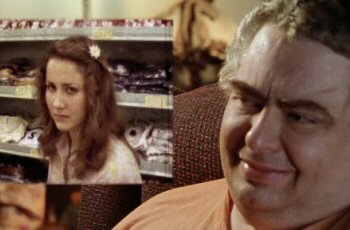
One of the decisive moments in Daniel�s life occurred when, as an art student at Kent State University, he met Laurie Allen, who would become his great love and his muse, though in a passive sense. Unbeknownst to Daniel at the time, Laurie had a boyfriend, who was away at college. She eventually married the boyfriend, which, while heartbreaking, allowed Daniel to pine for her, to pour these emotions into his songs�and the fact that her husband was a mortician made the story even better. (Daniel once attended a funeral at Laurie�s husband�s funeral home, the impetus for the lyrics to �Grievances�: �I saw you at the funeral / You were standing there like a temple / I said �Hi, how are you, hello� / And I pulled up a casket and crawled in.�) In his sole recent onscreen appearance, Daniel reminisces about �The girl of my dreams, so wonderful, so beautiful�She inspired a thousand songs, and then I knew I was an artist.� Super 8 footage of Laurie blowing kisses at him and giggling as he absconds with her cowboy boots plays in the corner of the screen, a tiny square that almost seems to depict Daniel�s thoughts, of how he remembers Laurie��frozen in time,� as Feuerzeig described it at a panel discussion during the 2005 South By Southwest film festival. The film implies that Laurie had no idea of what was actually going on, but in a DVD bonus feature, she reveals that Daniel used to send her drawings and tapes of the songs he�d written about her, which she considered harmless, even flattering. Daniel�s story is one of mythical proportions; he looms larger-than-life, his tale infused with the spirit of an urban legend�as Kathy McCarty, former Glass Eye member and longtime friend of Daniel�s, says in the film, he�s �left an incredible wake behind him.� After arriving in Austin via a traveling carnival, he started passing out his tapes to anyone who would listen. According to the film, he didn�t always have the ability to dub copies, and often had to sing the album all over again, from start to finish�a particularly Johnstonesque, if you will, action. His tapes found their way into the hands of Louis Black, Kathy McCarty, and others who helped him to establish a niche in the music scene; some immediately recognized his genius, while others weren�t sure how to react�as McCarty says, �he was so raw and so real in a lot of ways that people couldn�t take it.� McCarty also mentions how he �was unstoppable at that point...He always presented himself like, �I am a very incredible, extraordinary human being and you�re going to be really happy you listened to this.�� Incredibly, his obsessions and extreme narcissism have affected reality; he had the idea that he was �an extraordinary human being� and consequently was able to project that in real life. This is perhaps best exemplified in Daniel�s first MTV appearance: the proto-�120 Minutes� show �The Cutting Edge� came to town, and though he wasn�t a scheduled performer, he not only finagled an appearance on the show, but managed to steal the spotlight in the process. 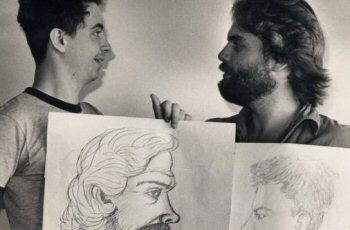
Around this time he became obsessed with the devil (hence the title), which poses questions about his background. David Thornberry, one of Daniel�s best friends, states early on in the film that Daniel was �spiritually separated from [his family]�But at the same time, he was of them.� When his mother accuses his cartoons of being Satanic, he laughs it off; when his illness kicks in, he starts accusing his family of being Satanists, proselytizing his audiences about how the number of the beast is 6, and Jesus is number 7 (he can�t help throwing in a Beatles-related joke: �number 9, number 9, number 9�). It�s almost as if he�d really been taking all of his family�s lectures to heart and was now somehow overcompensating, trying to be a good Christian after all. Not to say that his upbringing can be blamed for his illness�it is, however, an interesting side effect. In one audio recording, Daniel provides a brief, yet revealing insight into the workings of his mind: �I was looking through the Bible and it said that Daniel was a dreamer and interpreter of visions. I see a lot of these things that come to me as sort of a vision. It�s just like something that appears to me, like, in a really wild way, strangely and magically.� In a review of Daniel�s records on emusic.com, Feuerzeig describes how �if you observe him long enough, he will eventually let out a loud guffaw at a joke that only he has heard.� One can only imagine the visions Daniel sees on a regular basis�an enchanting play, both comedy and tragedy, being performed continuously in the theater of his mind, which we occasionally catch a glimpse of through his music and drawings. 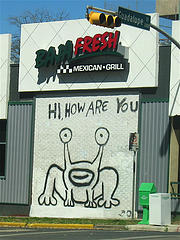
The plight of Jeff Tartakov, Daniel�s first manager, is a rather significant subplot of the film. (In a Slant Magazine interview, Feuerzeig says, �I made this film as much for Tartakov as for Daniel.�) He�s likened to the main character in the Woody Allen film �Broadway Danny Rose,� who was indefatigably devoted to his clients. Tartakov was in contact with members of various bands, including Sonic Youth and Half Japanese�he was the original source of the legendary �Hi, How Are You� T-shirt that found its way into the hands of Kurt Cobain, who wore it in a number of MTV appearances and photo shoots, quickly generating a buzz�which led to various collaborations and record deals. And yet, Daniel fired Tartakov as soon as he signed with Atlantic Records. (In Daniel�s defense, he was in a mental hospital when he made this decision.) Regardless, Tartakov was more or less screwed, falling into a deep depression, yet he continued to keep Daniel�s backlist in print via dubbed cassettes available through mail order, a perfect example of the level of his dedication. (As recently as December 2006, one could order over a dozen different cassettes and T-shirts through Tartakov�s website, but everything is now listed as �out of print,� the only explanation as follows: �It�s been an honor and a pleasure to produce these cassettes for over 20 years but due to circumstances beyond my control [they] are no longer available.�) 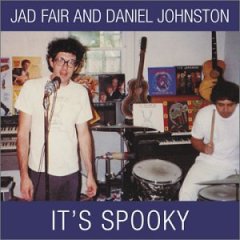
One of the results of Tartakov�s efforts is Daniel�s multiple collaborations with co-founding member of Half Japanese and kindred spirit Jad Fair, with whom Daniel has maintained a lasting relationship�and he�s also the focus of Jeff Feuerzeig�s first feature-length film, �Half Japanese: The Band that Would Be King.� Brothers Jad and David Fair are, as described by Half Japanese guitarist Mark Jickling, the classic archetypal pair: the nervous, stuttering, skinny guy, and the big, carefree, outgoing guy, creating a balance, an equilibrium within the band. They grew up outside of Ann Arbor, Michigan, a fairly auspicious location, as they found themselves in the midst of Detroit bands like the MC5 and the Stooges (says David, �In other parts of the country, I don�t know what [people] had, but you can�t beat the �5 and the Stooges��and you really can�t). The brothers started playing music together in Michigan but, as far as I can tell, the first incarnation of Half Japanese as a band didn�t form until 1977, after their family moved to Uniontown, Maryland. As in �The Devil and Daniel Johnston,� the subjects� parents are interviewed�while they look pretty conservative (think �Cosby sweaters�), they seem genuinely enthusiastic and encouraging. Mrs. Fair does most of the talking, at one point saying, �Our house has been called the birthplace of punk rock, and that is really exciting.� She also describes how the family dog would hide under the couch whenever they practiced �just because it was loud,� and tells a charming story about how someone from Armageddon Records came by to draft a contract with the band, and Jad kept coming downstairs to get more Coke (the soda, of course). This contract would result in the release of �Half Gentlemen/Not Beasts� (not beasts �cause we�re nice guys�), a three-album box set that included a poster and 20-page booklet. Upon learning of the format of this next release, Byron Coley, one of the film�s commentators (and somewhat of a staple among music documentaries: see �Jandek on Corwood,� �We Jam Econo,� or �You�re Gonna Miss Me�), �was as astounded as the next man��and though it�s highly unusual for a virtually unknown band to release an album with such over-the-top packaging, this box set reflects the magnitude of Jad�s and David�s creativity and uniqueness. 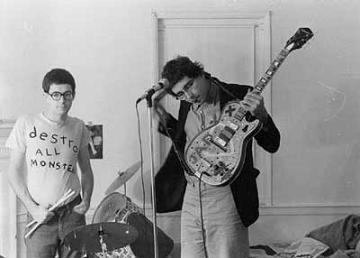
Throughout the film, the Fair brothers impart various gems of wisdom that, while some might think them na�ve (or just kidding), a young, potential musician might find encouraging, and maybe even life-changing�not to mention that the endearingly simple logic behind their words makes me fall just a little more in love with them. They strongly emphasize that you don�t have to be an aficionado in order to play music�a lack of technical proficiency allows one to take a more creative approach, which certainly contributed to the sound of Half Japanese. Jad explains that �I had never played guitar before, had never played drums before starting Half Japanese, but on day one of the beginning of the band, I was both a drummer, guitarist, vocalist, and anything else I would put in my hands.� Similarly, David offers an ingenious guitar lesson: �The little, skinny [strings] make high sounds, and the big, fat ones make low sounds�if you want to be fast, play fast, and if you want to go slow, go slow (here he indicates the speed with strumming motions)�For what I was doing, that was the beauty of it, you could learn it that first day.� While David asserts that they always played the best they could, they were also quite purposeful in their methods. I�m certain that they could have learned all those boring chords and scales if they really wanted to�their mark of brilliance is that they deliberately chose note to. There is an abundance of black and white live footage scattered throughout, mostly current to the filming. It sounds like the band has learned a couple of chords over the years, but their style has developed through their having played and practiced so much, not from any formal instruction. There�s more of a traditional pop structure under the noise, but it retains a peculiar, slightly off-key quality that is decidedly Half Japanese. Early on, David says, �We do two kinds of songs: love songs and monster songs,� and I think that classification was maintained for the duration of the band�s existence. In addition to band members and family, some of the film�s commentators include former Velvet Underground drummer Moe Tucker, with whom the band has collaborated; David Greenberger of the zine �Duplex Planet� (a rather memorable scene in the film occurs when the band plays a set at the Duplex Nursing Home, one elderly resident spontaneously playing along on his harmonica); prolific music critic/archivist/pundit Byron Coley (throughout his interviews he keeps a copy of Moe Tucker�s �Playin� Possum� prominently displayed, which inspired at least one household to track down a copy of the record); Matador Records CEO Gerard Cosloy (according to rumor, he wore dark glasses in all of his interviews because he had a black eye, although I can�t find information confirming this); and illusionist Penn Gillette, who decided to justify his appearances on �Miami Vice� by using the money he made to finance the release of Half Japanese records on 50 Skidillion Watts (�I paid a lot for these records but I enjoy them�). The general tone many of these people convey is a kind of smartass, in-the-know attitude�if you get it, you get it, and if you don�t, it�s your loss�which makes for some pretty amusing remarks that seem to be lost on some less clued-in viewers. I was surprised to find a number of online reviews that referred to this film as a mockumentary, as if the reviewer couldn�t fathom the possibility that people might actually like this music, that the commentators are serious. Gerard Cosloy is especially guilty of thinly veiled sarcasm, but to me it seems clear that even when he�s making hyperbolic assertions that �people lack the intestinal fortitude to really check this band out� (in the same breath he also says that when witnessing them perform one shouldn�t make any sudden movements or use flash photography), he�s amusing himself, yet he�s absolutely sincere (and hilarious, I might add). But then, it�s kind of hard to tell whether someone is sincere when you can�t see his eyes. 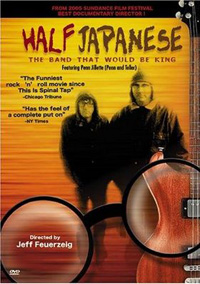 �The Band That Would Be King� is as much a chronicling of the band�s evolution as it is a bitter diatribe against corporate, major label rock and MTV. Just about every commentator has something disdainful to say about the dreaded cable network. Moe Tucker, at various points, uses words like �extremely offensive,� �sick,� and �disgusting� to describe them; Byron Coley bitterly recounts how he immediately mailed his cable box back to his provider when they attempted to add MTV to his subscription (�Thou shalt not charge me for this, friends!�); Penn Gillette explains how, as a guest VJ, he was only permitted to show 11 seconds of the band; Gerard Cosloy laments of how people consult MTV for their rock history, the more �adventurous� souls resorting to �120 Minutes.� (Cosloy�s somewhat backhanded objections to major labels��I don�t think there�s necessarily anything bad about a major label record, and as soon as one comes out I would be very happy to buy it��strike me as particularly interesting, as Matador has had various involvements with the majors over the years, as early as 1993, the year this documentary was released.) While the members of Half Japanese proudly endorse (embody, even) DIY ethics and criticize MTV as an unnecessary and unwanted evil, Daniel Johnston fully embraces the culture of superstardom�when he appears on �The Cutting Edge� he�s absolutely beaming, holding up his tape and babbling about how he�s finally made it onto MTV. It had such an impact on him that five years later he was still singing about how �I was on MTV, everybody was lookin� at me� (in �Held the Hand,� off the �1990� album). It�s incidental that Daniel�s been embraced by indie rock listeners, that he�s still more of a cult phenomenon than a pop star�his aspirations are much more grandiose. Essentially, he wants to be the Beatles, both in sound and scale. The average listener, however, is unlikely to look past his technical inabilities (he can�t really sing or play guitar, though he�s a gifted pianist) or the recording quality of his earlier work. Countless musicians have covered his songs in more palatable renditions (I must say, I prefer the originals), showcasing his prolific songwriting, which seems to me proof enough that he is immensely talented. The world at large simply isn�t ready for him, or for Half Japanese. There seems to be an underlying sentiment in �The Band That Would Be King� insinuating that if the entire world were populated by Half Japanese fans, it would be a utopia�while maybe a little far-fetched, there is a degree of truth to that statement. Picture a world full of progressive, open-minded people (which, I think, is required in order to listen to and love this band), and I think you�ll begin to see what I mean. When Moe Tucker says, �Half Japanese is the band that would be king if they were given the opportunity,� I picture (somewhat facetiously) Jad with a crown and scepter, taking his rightful position on a throne. (My boyfriend would like to argue that �David is the king, duh.�) Stylistically, �The Band That Would Be King� is a more straightforward documentary, though one can discern aesthetic similarities to �The Devil and Daniel Johnston.� Towards the beginning, there is a close-up on a record player with the needle dropping on �Calling All Girls,� which reminds me of some of the camerawork in the latter film; in another scene, as the Fairs go into detail about the topic of their song �Thing with a Hook� (the urban legend about the hook-handed killer who attacks couples �down in lover�s lane�), they venture into a dark basement, flashlights illuminating their faces, evoking the sharing of a spooky campfire tale. Since then, Feuerzeig has been developing his voice as a filmmaker. In �The Devil and Daniel Johnston� he �merges� genres, via the archival source materials and art-directed reenactments, producing a documentary with the effect of a narrative film. The concept is expanded upon even further in his current project, a hybrid film about boxer Chuck Wepner, the basis for the character of Rocky Balboa; it will feature interviews with the real Wepner, as well as an actor playing him, a la �American Splendor.� Each of these documentaries concludes on a note that seems to sum up the feeling of the entire film. �The Band That Would Be King� ends with an anecdote from Jad that perfectly expresses the oddball wit that permeates throughout. �The Devil and Daniel Johnston,� on the other hand, leaves me feeling wistful, most likely because of the music, which serves as a more than appropriate soundtrack, emotionally�I�m smiling, partly at Daniel wearing his Casper costume, yet it�s a kind of bittersweet smile. |

|
|
Article by Sarah Janet. |
| PREVIOUS PAGE � HOME � NEXT PAGE |